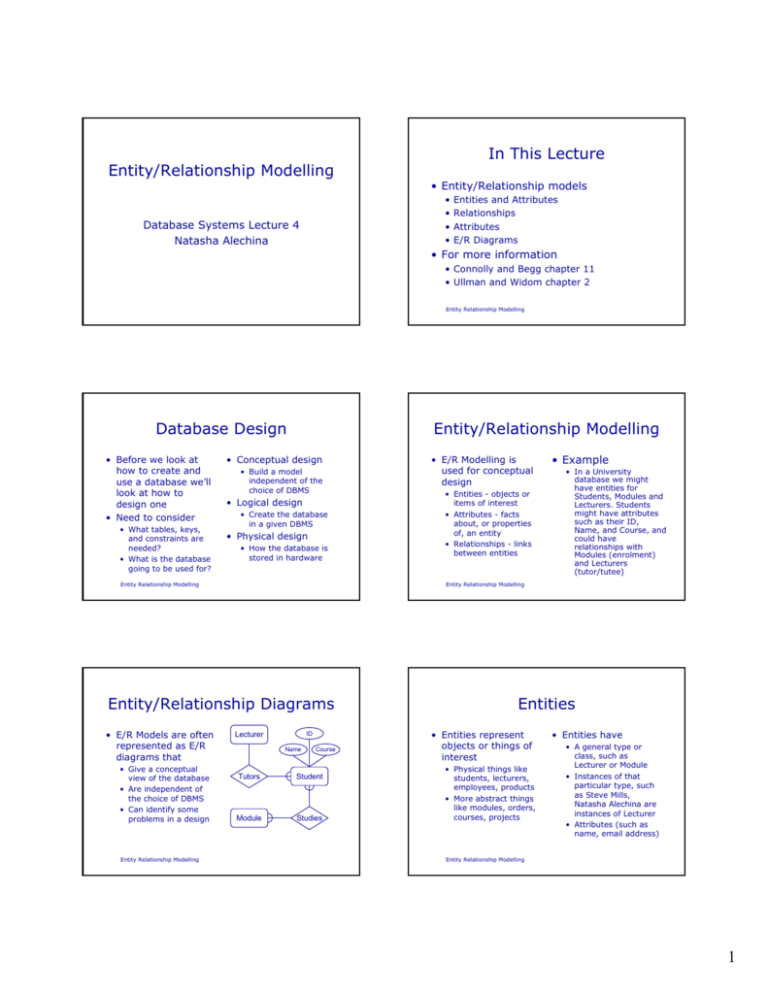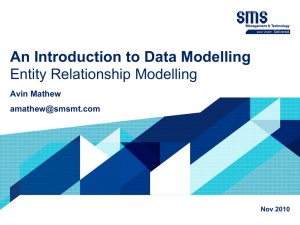Entity/Relationship Modelling In This Lecture Database Design
advertisement

Entity/Relationship Modelling In This Lecture • Entity/Relationship models • • • • Database Systems Lecture 4 Natasha Alechina Entities and Attributes Relationships Attributes E/R Diagrams • For more information • Connolly and Begg chapter 11 • Ullman and Widom chapter 2 Entity Relationship Modelling Database Design • Before we look at how to create and use a database we’ll look at how to design one • Need to consider • What tables, keys, and constraints are needed? • What is the database going to be used for? Entity/Relationship Modelling • Conceptual design • Build a model independent of the choice of DBMS • Logical design • Create the database in a given DBMS • Physical design • How the database is stored in hardware Entity Relationship Modelling • Give a conceptual view of the database • Are independent of the choice of DBMS • Can identify some problems in a design Entity Relationship Modelling • Entities - objects or items of interest • Attributes - facts about, or properties of, an entity • Relationships - links between entities • Example • In a University database we might have entities for Students, Modules and Lecturers. Students might have attributes such as their ID, Name, and Course, and could have relationships with Modules (enrolment) and Lecturers (tutor/tutee) Entity Relationship Modelling Entity/Relationship Diagrams • E/R Models are often represented as E/R diagrams that • E/R Modelling is used for conceptual design ID Lecturer Name Course Tutors Student Module Studies Entities • Entities represent objects or things of interest • Physical things like students, lecturers, employees, products • More abstract things like modules, orders, courses, projects • Entities have • A general type or class, such as Lecturer or Module • Instances of that particular type, such as Steve Mills, Natasha Alechina are instances of Lecturer • Attributes (such as name, email address) Entity Relationship Modelling 1 Diagramming Entities • In an E/R Diagram, an entity is usually drawn as a box with rounded corners • The box is labelled with the name of the class of objects represented by that entity Attributes ID Lecturer Name Course Tutors Student Module Studies • Attributes are facts, aspects, properties, or details about an entity • Students have IDs, names, courses, addresses, … • Modules have codes, titles, credit weights, levels, … Entity Relationship Modelling Relationships ID Lecturer Name Course Tutors Student Module Studies • Relationships are an association between two or more entities • Each Student takes several Modules • Each Module is taught by a Lecturer • Each Employee works for a single Department Entity Relationship Modelling Entity Relationship Modelling • Relationships have • A name • A set of entities that participate in them • A degree - the number of entities that participate (most have degree 2) • A cardinality ratio Entity Relationship Modelling Cardinality Ratios • Each entity in a relationship can participate in zero, one, or more than one instances of that relationship • This leads to 3 types of relationship… • A name • An associated entity • Domains of possible values • Values from the domain for each instance of the entity they are belong to Entity Relationship Modelling Diagramming Attributes • In an E/R Diagram attributes may be drawn as ovals • Each attribute is linked to its entity by a line • The name of the attribute is written in the oval • Attributes have • One to one (1:1) • Each lecturer has a unique office • One to many (1:M) • A lecturer may tutor many students, but each student has just one tutor • Many to many (M:M) • Each student takes several modules, and each module is taken by several students Diagramming Relationships • Relationships are links between two entities • The name is given in a diamond box • The ends of the link show cardinality One ID Lecturer Name Course Tutors Student Module Studies Many Entity Relationship Modelling 2 Removing M:M Relationships • Many to many relationships are difficult to represent • We can split a many to many relationship into two one to many relationships • An entity represents the M:M relationship Student Student Has Studies Enrolment In Module Making E/R Models • To make an E/R model you need to identify • • • • • General guidelines • Since entities are things or objects they are often nouns in the description • Attributes are facts or properties, and so are often nouns also • Verbs often describe relationships between entities Enitities Attributes Relationships Cardinality ratios • from a description Module Entity Relationship Modelling Entity Relationship Modelling Example A university consists of a number of departments. Each department offers several courses. A number of modules make up each course. Students enrol in a particular course and take modules towards the completion of that course. Each module is taught by a lecturer from the appropriate department, and each lecturer tutors a group of students Entity Relationship Modelling Example - Relationships • A university consists of a number of departments. Each department offers several courses. A number of modules make up each course. Students enrol in a particular course and take modules towards the completion of that course. Each module is taught by a lecturer from the appropriate department, and each lecturer tutors a group of students Example - Entities A university consists of a number of departments. Each department offers several courses. A number of modules make up each course. Students enrol in a particular course and take modules towards the completion of that course. Each module is taught by a lecturer from the appropriate department, and each lecturer tutors a group of students Entity Relationship Modelling Example - E/R Diagram Entities: Department, Course, Module, Lecturer, Student Department Course Module Lecturer Student Entity Relationship Modelling Entity Relationship Modelling 3 Example - E/R Diagram Each department offers several courses A number of modules make up each courses Department Offers Course Example - E/R Diagram Department Offers Module Lecturer Course Module Includes Student Student Entity Relationship Modelling Entity Relationship Modelling Example - E/R Diagram Students enrol in a particular course Course Department Offers Module Includes Example - E/R Diagram Students … take modules Department Offers Lecturer Lecturer Course Module Includes Lecturer Takes Student Enrols In Entity Relationship Modelling Entity Relationship Modelling Example - E/R Diagram Each module is taught by a lecturer Course Includes Module Example - E/R Diagram a lecturer from the appropriate department Department Offers Student Enrols In Department Offers Teaches Lecturer Course Includes Takes Enrols In Entity Relationship Modelling Student Module Employs Teaches Lecturer Takes Enrols In Student Entity Relationship Modelling 4 Example - E/R Diagram Example - E/R Diagram each lecturer tutors a group of students Department Offers Course Includes Module Teaches Department Employs Offers Lecturer Course Module Includes Takes Tutors Entity Relationship Modelling • They both represent objects or facts about the world • They are both often represented by nouns in descriptions • General guidelines • Entities can have attributes but attributes have no smaller parts • Entities can have relationships between them, but an attribute belongs to a single entity product description price supplier address phone number name street address city postcode Entity Relationship Modelling Example We want to represent information about products in a database. Each product has a description, a price and a supplier. Suppliers have addresses, phone numbers, and names. Each address is made up of a street address, a city, and a postcode. Entity Relationship Modelling Example - Entities/Attributes • • • • • • • • • • Tutors Entity Relationship Modelling Entity Relationship Modelling • Entities or attributes: Lecturer Student Enrols In Entities and Attributes • Sometimes it is hard to tell if something should be an entity or an attribute Teaches Takes Student Enrols In Employs • Products, suppliers, and addresses all have smaller parts so we can make them entities • The others have no smaller parts and belong to a single entity Example - E/R Diagram Price Description Product Street address Name Supplier Address Phone number Postcode City Entity Relationship Modelling 5 Example - Relationships • Each product has a supplier Example - E/R Diagram Price • Each supplier has an address • Each product has a single supplier but there is nothing to stop a supplier supplying many products • A many to one relationship • A supplier has a single address • It does not seem sensible for two different suppliers to have the same address • A one to one relationship Entity Relationship Modelling Description Product Has A Name Supplier Street address Address Has A Phone number Postcode Entity Relationship Modelling One to One Relationships • Some relationships between entities, A and B, might be redundant if • Example - the supplier-address relationship • It is a 1:1 relationship between A and B • Every A is related to a B and every B is related to an A • Is one to one • Every supplier has an address • We don’t need addresses that are not related to a supplier Redundant Relationships • We can merge the two entities that take part in a redundant relationship together • They become a single entity • The new entity has all the attributes of the old one b a x A B c z a y z Entity Relationship Modelling Example - E/R Diagram Price Making E/R Diagrams • From a description of the requirements identify the Product • • • • Has A Name Supplier City Phone number Postcode Street address Entity Relationship Modelling y x AB b c Entity Relationship Modelling Description City Entities Attributes Relationships Cardinality ratios of the relationships • Draw the E/R diagram and then • Look at one to one relationships as they might be redundant • Look at many to many relationships as they might need to be split into two one to many links Entity Relationship Modelling 6 Debugging Designs • With a bit of practice E/R diagrams can be used to plan queries • You can look at the diagram and figure out how to find useful information • If you can’t find the information you need, you may need to change the design Debugging Designs ID Student Student Name Has Enrolment In How can you find a list of students who are enrolled in Database systems? Has ID Enrolment Code Module Module Title This Lecture in Exams (and coursework 2007/8) “A database will be made to store information about patients in a hospital. On arrival, each patient’s personal details (name, address, and telephone number) are recorded where possible, and they are given an admission number. They are then assigned to a particular ward (Accident and Emergency, Cardiology, Oncology, etc.). In each ward there are a number of doctors and nurses. A patient will be treated by one doctor and several nurses over the course of their stay, and each doctor and nurse may be involved with several patients at any given time.” Entity Relationship Modelling (2) Find instances of the Enrolment entity with the same Code as the result of (1) In Code Entity Relationship Modelling (3) For each instance of Enrolment in the result of (2) find the corresponding Student (1) Find the instance of the Module entity with title ‘Database Systems’ Entity Relationship Modelling This Lecture in Exams Identify the entities, attributes, relationships, and cardinality ratios from the description. (4 marks) Draw an entity-relationship diagram showing the items you identified. (4 marks) Many-to-many relationships are hard to represent in SQL tables. Explain why many-to-many relationships cause problems in SQL tables, and show how these problems may be overcome. (4 marks) Entity Relationship Modelling Next Lecture • SQL • The SQL language • SQL, the relational model, and E/R diagrams • CREATE TABLE • Columns • Primary Keys • Foreign Keys • For more information • Connolly and Begg chapter 6 • Ullman and Widom chapter 6.5, 6.6 Entity Relationship Modelling 7






